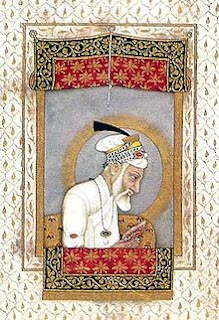During the Ayodhya controversy, there were occasional statements in the Hindutva camp confirming (VHP) or denying (BJP) that apart from Ram Janmabhoomi, two other sacred sites should also be "liberated" from Islamic "occupation": Krishna Janmabhoomi in Mathura and Kashi Vishvanath in Varanasi. Though the Hindu business community in central Varanasi has made it clear that it refuses to suffer the inevitable losses which would accompany an agitation in their densely populated neighbourhood, the liberation of Kashi Vishvanath is still on the VHP's agenda. Therefore, some authors have tried to "do an Ayodhya" on Kashi, viz. try to make people believe that there never was a Hindu temple at the disputed site. Syed Shahabuddin asserts that Muslims cannot possibly have destroyed any Hindu temple, because "pulling down a place of worship to construct a mosque is against the Shariat"; claims to the contrary are all "chauvinist propaganda." Arun Shourie has confronted this claim with the information given in the official court chronicle, Maasiri Alamgiri, which records numerous orders for and reports of destructions of temples. Its entry for 2 September 1669 tells us: "News came to court that in accordance with the Emperor's command his officers had demolished the temple of Vishvanath at Banaras" . Moreover, till today, the old Kashi Vishvanath temple wall is visible as a part of the walls of the Gyanvapi mosque which Aurangzeb had built at the site. R
In the face of such direct testimony, it is wiser not to challenge facts headon. It is better to minimize or to justify them. Thus, Percival Spear, co-author (with Romila Thapar) of the prestigious Penguin History of India, writes: "Aurangzeb's supposed intolerance is little more than a hostile legend based on isolated acts such as the erection of a mosque on a temple site in Benares." But a perusal of the same Moghul chronicle thoroughly refutes this reassuring assertion: Aurangzeb had thousands of temples destroyed. And other chronicles, diaries and other documents concerning Muslim rulers in India prove that the practice was not a personal idiosyncrasy of Aurangzeb's either. Therefore, a more promising way of defusing the conflict potential which the mosque at the Kashi Vishvanath site carries, is to justify the replacement of the temple with a mosque. Maybe the owners and users of the temple had brought it on themselves? Maybe Islam can be disentangled from this act of destruction in favour of a purely secular motive?
Temple Desecration in Pre-modern India Richard M Eaton
JNU historian Prof. K.N. Panikkar offers one way out: "the destruction of the temple at Banaras also had political motives. It appears that a nexus between the sufi rebels and the pandits of the temple existed and it was primarily to smash this nexus that Aurangzeb ordered action against the temple." The eminent historian quotes no source for this strange allegation. In those days, Pandits avoided to even talk with Mlecchas, let alone to concoct intrigues with them. Other secularists have spread a more sophisticated variation, now regularly reproduced in the media: "Did Muslim rulers destroy temples? Some of them certainly did. Following the molestation of a local princess by some priests in a temple at Benaras, Aurangzeb ordered the total destruction of the temple and rebuilt it at a nearby site. And this is the only temple he is believed to have destroyed." This story is now repeated ad nauseam, not only in the extremist Muslim press and in the secularist press but also in academic platforms by "eminent historians". It is repeated with approval by historian Gargi Chakravartty, who also reveals the source of this story. She introduces the quotation as follows: "Much has been said about Aurangzeb's demolition order of Vishwanath temple at Banaras. But documentary evidence gives a new dimension to the whole episode:" What follows is the theory launched by B.N. Pande, working chairman of the Gandhi Darshan Samiti and former Governor of Orissa: "The story regarding demolition of Vishvanath temple is that while Aurangzeb was passing near Varanasi on his way to Bengal, the Hindu Rajas in his retinue requested that if the halt was made for a day, their Ranis may go to Varanasi, have a dip in the Ganges and pay their homage to Lord Vishwanath. Aurangzeb readily agreed. Army pickets were posted on the five mile route to Varanasi. The Ranis made a journey on the Palkis. They took their dip in the Ganges and went to the Vishwanath temple to pay their homage. After offering Puja all the Ranis returned except one, the Maharani of Kutch. "A thorough search was made of the temple precincts but the Rani was to be found nowhere. When Aurangzeb came to know of it, he was very much enraged. He sent his senior officers to search for the Rani. Ultimately, they found that the statue of Ganesh which was fixed in the wall was a moveable one. When the statue was moved, they saw a flight of stairs that led to the basement. To their horror, they found the missing Rani dishonoured and crying, deprived of all her ornaments. The basement was just beneath Lord Jagannath's seat. The Rajas expressed their vociferous protests. As the crime was heinous, the Rajas demanded exemplary action. Aurangzeb ordered that as the sacred precincts have been despoiled, Lord Vishvanath may be moved to some other place, the temple be razed to the ground and the Mahant be arrested and punished." REFERENCE: Why did Aurangzeb Demolish the Kashi Vishvanath? Koenraad Elst © Dr. Koenraad Elst




No comments:
Post a Comment